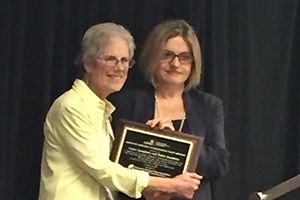Research
SPA's Langbein Receives Award at APPAM for Comparative Research Analysis

Laura Langbein accepts the JCPA and ICPA-Forum's Best Comparative Paper Award at the APPAM 2015 Fall Research Conference.
Laura Langbein, SPA professor, and Pablo Sanabria, SPA/PhD ’12, examined the relationship between changes in laws and their effects on bribe-seeking in Central and South American countries, finding little to no association between the variables. “Improving civil service laws and practice does not appear to be associated with reduced propensity of civil servants on the street to seek bribes,” they write.
Langbein presented the pair’s work, “Independent Professional Bureaucracies and Street-Level Corruption: Evidence from Latin America”, at the APPAM 2014 Fall Research Conference, where it was subsequently awarded the JCPA and ICPA-Forum’s Best Comparative Paper Award. Both Sanabria and Langbein will be recognized at this year’s APPAM Fall Research Conference.
Langbein and Sanabria’s findings are unique given that previous research on corruption tends to be cross-national, rather than within a state’s borders. Cross-national research on corruption “shows that nations with stronger anti-corruption laws have less corruption,” says Langbein. Therefore, “over time if you change laws at ‘x’ time in the past, you would expect decreased corruption. We find that does not happen.” Their findings may go against previous expectations, however, Langbein also points out that they are hardly surprising. “Previous research shows that corruption is very stable, and very local.”
Sanabria, who now serves as a faculty member at the University of los Andes—one of South America’s top five universities—began writing and researching with Langbein as her research assistant during his time studying at SPA. Both will present additional research on corruption at APPAM 2015, this time unpacking it as a form of social capital between individuals.

